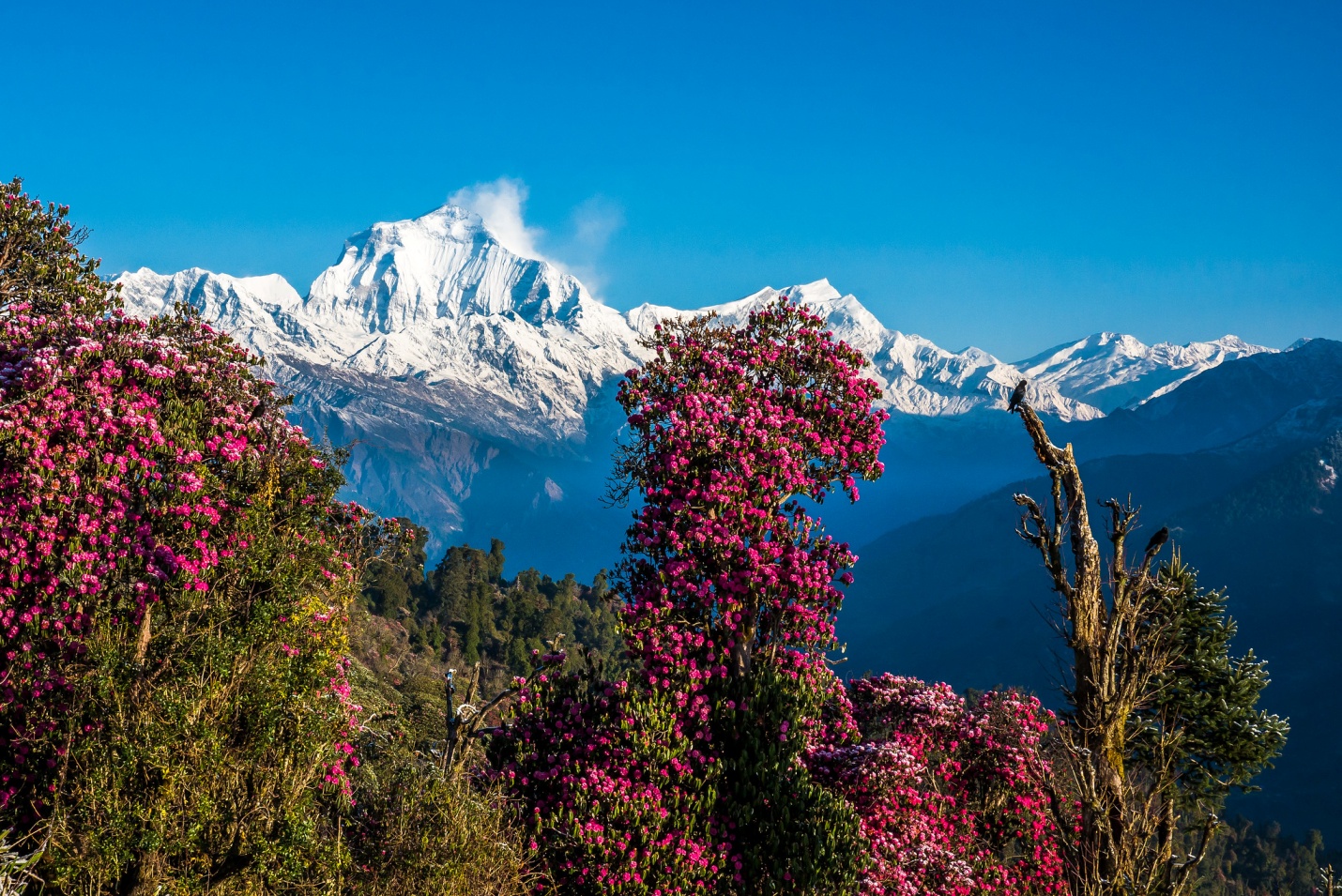The Annapurna base camp is a classic place in Nepal where you can experience the rich cultural heritage along with trekking and other adventurous activities. The Annapurna base camp trek is a popular adventurous activity among trekkers and nature lovers.
The normal ABC itinerary is of 12 days in which you will trek to the elevation of 4130m at the base of the Annapurna I. Along the way, you will get to know the diverse landscapes and rich biodiversity.
The special thing that you shouldn’t forget is the stunning views of the Annapurna Massif and the beautiful villages of the Gurung and Magar community. The trek is moderately difficult and gives you a memorable Himalayan experience.
You can go for the ABC trek during the spring and autumn season. This season gives you the best experience compared to the other seasons. The temperature is mild, weather conditions are stable, and so on.
Moreover, the Short Annapurna base camp trek is also popular because of the freedom of trekking in just short days. You can go for trekking, either solo or in group. The route of the ABC can be trekked independently with the help of the necessary gear and preparations.
Both of the treks have pros and cons. Solo trekking is the trek I. You independently trek to your desired destinations and return. This trek gives you the ultimate freedom and adventure along the way.
In addition, you can set your itinerary for solo trekking. But, there are certain disadvantages of solo trekking also. You have to deal with various challenges of your own like carrying gears, finding the right paths, and other risks.
On the other hand, a group trek is a safe way to trek in remote areas compared to the solo ABC trek. You get the support, guidance, and friends at group trekking. This way of trekking is helpful to those with no prior experience.
But, there are disadvantages of the group trekking also. You may miss the private trekking experience and have to adjust according to the group decisions or the itinerary. In addition, the group always moves according to slow movers. So, if you are a fast mover, you may feel uneasy.
Read the blog till the end to know about the pros and cons of solo vs group trekking in the ABC in detail.

Solo Trekking
In solo trekking, you will guide yourself without anyone’s help. There are some advantages that you can take while going solo trekking while there are some drawbacks also that you have to bear on the way.
- Pros of solo trekking
- Freedom and flexibility
You have the freedom to plan your itinerary, based on your fitness level and tiredness. There is no boundary to the plan or decisions you make along the way. You can enjoy total freedom and have the power to change your plan according to the circumstances.
- Self-discovery and growth
As you trek through the remote areas, you find out the hidden talent inside you that you never knew when you were in your comfort zone. This is a lifetime opportunity to do something independently in remote areas of mountains.
- Private trekking experience
As you trek solo, you can enjoy the private trekking experience. There will be minimal distractions and maximum time to enjoy the natural beauty and cultural encounters.
- Cost savings
You can do cost savings by not hiring a guide and porter. If you are an experienced trekker, you can find the path of your own and can easily do the necessary preparations required for the trek.
- Cons of solo trekking
- Isolated and lonely journey
The solo trekking is a alone journey to the remote areas. You have no one to talk either guide or your fellow mate. You may meet some of the trekkers on the way but they have their itinerary and may not have the time to talk to you.
- Risky and unsafe
Going for the solo is a risky journey. Especially, when you are in trouble and get hurt, you may barely find anyone to help as it is a remote area. Also, there will be no one to guide you through the unknown paths.
- Possibility of wildlife attacks
As you are trekking through the place where wildlife resides, there is the chance of wildlife attacks. The problem is common in the areas like forests, and conservation areas.
- Language barriers
As you are traveling from a foreign country or even a native country, you may be unfamiliar with the native language of the area. Not all the people of the teahouses are educated or know English well.
- Extra time and energy
For solo trekking, you have to plan all things on your own from itinerary to backpacking and pre-booking of the flights and accommodations. This activity takes a lot of time and effort.
Group Trekking
Group trekking is trekking with two or more two people to the same destination and itinerary. It has advantages as well as disadvantages. To know, make sure to read till the last.
- Pros of group trekking
- Safety and logistic support
One of the pros of group trekking is you have a porter to manage your backpack and a guide to guide you through the safe paths. You can feel safe and secure in the group.
- Shared experiences and fellowship
In group trekking, you can learn new things from the experiences of your fellow mates. There will be some to talk to and help while you are in trouble.
- Easy to arrange accommodations
It is easier when the guide manages the booking of the accommodations at teahouses. There may be problems in managing the accommodations in the peak season. So, the contacts of the guides can be very beneficial.
- Cons of the group trekking
- Less flexibility in itinerary
You may have less freedom to choose your itinerary as the decision of the majority group members matters.
- Potential conflicts
Not all come from the same background and have the same mindset as you. There may be a clash of opinions leading to potential conflicts. You may have to adjust to the itinerary and rest days that you don’t need.
- Limited personal exploration
While trekking with the group members, you may lack the in-depth cultural exploration and interactions with the locals.
Comparison
As the above pros and cons discussion of the solo trekking vs group trekking to the Annapurna base camp, you have the general ideas on them. Both have good sides and bad sides. The choice of what to choose to go to the trek mainly depends on your experience, fitness level, and your planning ability.
While the Nepal Tourism Board has made it mandatory to take a licensed and experienced guide with you, you can still experience the solo trekking experience differently than the group trekking. Read the comparison that will help you I’m choosing the solo trek vs group trek for the ABC trek.
- Cost considerations
The cost differences are the major reasons behind the influence on your choices to do a solo trek or group trek. Here is the general cost breakdown of the solo trekking vs group trekking.
- Permits and passes
For the Annapurna base camp trek, you will need the important permits and passes. It is the same for the group trekkers and solo trekkers.
- TIMS card- NPR 2000/US$17 per person
- Annapurna conservation area Permit- NPR 3000/US$25 per person
- Guides or porter
The cost is same for the solo or group travelers.
- Guide cost-$25-$30 per day
- Porter cost-$15-$20 per day
- Accommodations
For solo trekkers, the cost is $25-$50 per day for lodges.
- Food- NPR 300- 700 per meal
- Equipment like boots, backpacks, and so on.-NPR 25,000 to 40,000.
For group trekkers, the package price starts from $500 per person.
- Food- included in the package costs.
- Equipment- shared among trekkers or provided by the company.
- Lodging- cost includes in the packages.
- Experience and skill level required
For a solo trek in the Areas of the Annapurna region, you have to be in good health and have some trekking experience. This requirement is important because you may face various challenges including steep trails and long walks.
In addition, for the group trekkers, you can go for the Annapurna base camp trek even if you are a beginner. You will be accompanied by a guide, a porter, and your fellow trekking mates. The main benefit of group trekking is that you can have shared resources and support each other while facing challenges.
- Environmental impact
In terms of the environmental impacts, solo trekkers have less impact on the environment of the Everest region than group trekkers. The solo trekkers tend to generate less waste than the group trekkers and leave smaller footprints.
As the history says, the group generates more waste. So, whether you are trekking solo or in a group, the waste generation should be minimized and the environment should be conserved.
Get the latest scoop and updates on gossips.blog




